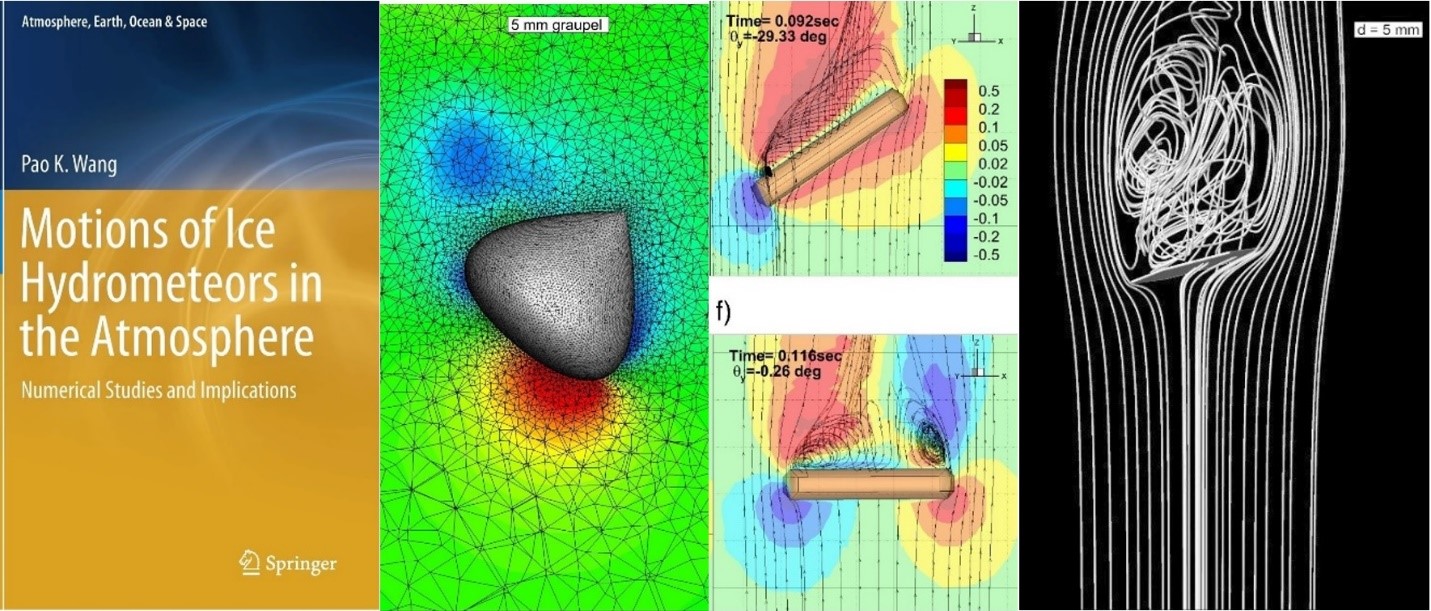


(left to right): (1) Book cover (2) An example of the numerical grid for conical graupel. Color represent pressure field. (3) Two examples of the flow fields around a freely falling hexagonal ice column. Black contours are streamtraces and colors are pressure fields. (4) Streamtraces around a falling hexagonal ice plate.
The puffy white clouds floating in the blue sky often inspire a leisurely sentiment, yet they actually play a very important role in the earth’s atmosphere. The most familiar to the public is that they may produce rain or snow when they are thick enough, and may even produce thunderstorms that cause severe weather disasters. But relatively few realize that clouds also have huge impact on the long-term climate. This is due to the strong influence of clouds on radiation – be it short wave solar radiation or long wave terrestrial radiation. For example, low clouds tend to act more in reflecting solar visible lights whereas high clouds tend to act more in trapping terrestrial infrared radiation. Consequently, the amount of high clouds and low clouds impacts directly the reception or interception of radiation, and therefore influences the long-term climate. Thus, the cloud amount and how long clouds can exist in the atmosphere have decisive impact on the future trend of climate. In fact, the IPCC reports have identified the cloud factor (along with the cloud interaction with aerosol) as the single largest source of uncertainty when using climate models to predict future climate.
All clouds are ensembles of their constituent particles that may be water drops or ice particles or both. The size, concentration and life span of these particles therefore decide the development stage of the cloud and its longevity. But what controls the growth or dissipation of these particles? Aside from the humidity in the atmosphere, the most important factor is the motion state of these particles. The motions of particles decide on how they can collide and coalesce with each other. How fast they can grow by vapor diffusion or how fast they will evaporate. And diffusion growth and evaporation involve the release or absorption of latent heats which are the energy source driving the cloud dynamical process.
But particles in clouds are very complex – they have many different kinds with milliards of sizes and different shapes and properties, especially those of ice particles. That’s why research on the motion of ice articles has been an important subject of cloud physics. But difficulties in experiments and complexities in theoretical studies had impeded the progress in this aspect.
This book summaries the research results of our group in recent years utilizing the computational fluid dynamics (CFD) techniques to solve numerically the 3-D free fall motions of ice crystals, snowflakes, graupel and hailstones. This is the first time in the world that the detailed theoretical 3-D flow fields around the true freely falling ice particles are obtained. They simulate in great detail the possible motions of these particles, such as rotation, vibration, zigzag, tumbling and spiraling, and these motions all occur in appropriate conditions agreeing with experimental data. In addition, we also provide the ventilation coefficients which are necessary for accurately estimate the diffusion growth or evaporation rates. This book is important to researchers in atmospheric science, especially cloud physics, and may also be useful for fluid dynamicists who are interested in understanding the fluid mechanics of complex bodies.
Key points
More information